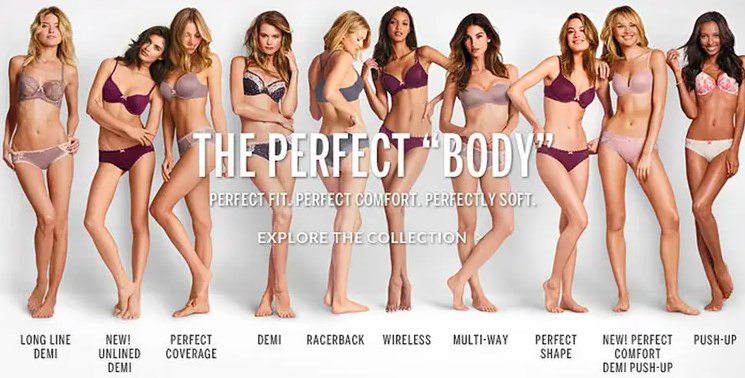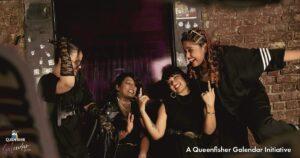Victoria’s Secret, a lingerie brand that has always held an aspirational space in a woman’s cupboard, is going through a complete revamp. The brand which was sexy, smouldering and in most cases, unattainable (because who actually looks that good in everything), realised what it was doing wrong, and decided to fix it.

As a young girl, I found myself looking up to these models, watching these shows in awe – is this what it meant to be a woman? Only to find out that, these shows weren’t really about women. They were, and continued to be, for an audience of predominently men.
Tyra Banks, Victoria’s Secret Fashion Show 2000

Miranda Kerr, Victoria’s Secret Fashion Show 2006

Victoria’s Secret, the brand which took a break and came back with a complete revamp in 2021, is yet to prove itself and its new inclusive range that promises to change how women look at the brand.
What are these fashion shows?
Founded by Roy and Gaye Raymond in 1977, VS began its fashion shows in 1995 and obviously, these shows became a talk of the town overnight. Models who were the perfect combination of skinny and curvy would walk the ramp in their undergarments, paired with glorious angel wings, as they got ogled by the likes of – Donald Trump in the audience.
Adriana Lima, Victoria’s Secret Fashion Show 2010

The fashion shows were for the male gaze, as they focussed on how glamorous the women looked – never talking to the women about empowerment and confidence. They showcased beautiful and often young models – Tyra Banks, Heidi Klum, Gisele Bündchen, Adriana Lima, Miranda Kerr and Karlie Kloss are some of the most prominent angels out there.
Alessandra Ambrosio, Victoria’s Secret Fashion Show 2017

Who are the Victoria’s Secret ‘Angels’?
The models who walk the ramp on these shows are called Angels. And there is a tough competition behind this selection process. In 2018, Alannah Walton became the youngest ever Victoria’s Secret Angel, at 18, a rather impressionable age.
These models have for years spoken about the extreme diets and workout regimes they get on, to maintain this ‘small waist size‘ fantasy that Victoria’s secret sells.
It’s a running joke that they see curvier girls every year and never cast them,” she says. “This whole starvation-camp situation before you have to walk that catwalk is ridiculous. Some of them are my friends on that stage; I’m not pulling them apart. But they have to put their bodies to such extremes once they cast the show, they couldn’t maintain that kind of lifestyle or they’d die.
-Model Robyn Lawley told The Guardian
Nothing like Victoria’s Secret, a company that perpetuates toxic diet culture and unrealistic body standards, promoting mental health awareness month 🙄
— _ (@paigeychu) May 20, 2021
Personally after all the toxic things about women’s bodies Victoria’s Secret has promoted over the years I’d be fine if the free market drove them under.
— Laura Chapin (@LauraChapin) June 16, 2021
The horrors that it perpetuated went beyond that fashion show, as the stories of models starving themselves to look a certain way starting making rounds. From cutting off solid food 9 days before the show, to not even having fluids, which led to serious dehydration and other problems, the lifestyle that this show propagated for years has been anything but healthy and admirable.
Heidi Klum, Victoria’s Secret Fashion Show 2001

Why was the 2019 show cancelled? And what lead to this complete change?
The US’s National Organization of Women (NOW) protested the fashion show, calling it a “softcore porn infomercial” in 2002. And years later, VS cancelled its iconic show for the first time in 2019. After being called out for the impossible body standards that it promoted, and also for not being inclusive when it came to sizes.
Not to mention, the fall in the sales of the company. The sales began to falter because the rest of the world was moving on from ‘sexy’ lingerie, onto comfortable bras, and Victoria’s Secret was busy selling the same old push-up bra fantasy. Even its market share in the US, dropped from 33% to 24%, as more body-positive and inclusive brands became the talk of the town.
VS also launched “The Perfect ‘Body.'” campaign back in 2014, that sparked controversy because it showed just one singular body type.

And so, after all the backlash the brand faced – instead of including more diversity and making the show inclusive and empowering, the brand decided to cancel it altogether.
Thinking about how Victoria’s Secret just ended the entire VF Fashion Show instead of just featuring more diverse bodies and gender identities…
— hilary_buff.mp4 (@TheHilaryBuff) August 10, 2021
victoria’s secret would rly rather cancel their entire show than rework it to be realistic & inclusive. all they had to do was revamp it & include more realistic models: plus size/trans/WOC/etc. and that fact that they chose to throw it all away rather than fix it is what’s gross
— holly🕷🕸 (@holly__distler) November 25, 2019
The anti-trans statements that were made by the company’s ex-CMO & the cover-up that followed still stay unforgotten.
The brand also wasn’t inclusive towards the trans community. In an interview with Vogue, Edward Razek, the former Chief Marketing Officer who helped developed the fashion show, said that he didn’t think the show should feature “transsexuals” because the show is a “fantasy.”
It’s a 42-minute entertainment special. That’s what it is.
-Edward Razek said to Vogue, before he apologised and stepped down.

However, the new and improved VS celebrated Pride month with a series of posts and has a prominent trans model and LGBTQA+ activist as its new brand ambassador. A bit hypocritical, but maybe a step in the right direction?
So who are these new ambassadors, if not ‘Angels’?
After doing away with the concept of ‘Angels’ altogether, the brand has now brought together a group of seven women to become its ambassadors as a part of the ‘VS Collective’.
Valentina Sampaio – VS’ first transgender model. Eileen Gu – a world champion freestyle skier. Adut Akech – a successful model who moved to Australia with her family, as a refugee. Priyanka Chopra – an actor, film producer and entrepreneur. Paloma Elsesser – a size-14 model who has actively campaigned for body positivity in the modelling industry. Amanda De Cadenet – a journalist and photographer. Megan Rapinoe – an American footballer.
Where does Victoria’s Secret stand on body-positivity now?

After years of criticism and being called out for their toxic behaviour, Victoria’s Secret finally made the decision to completely overhaul its image. It began promoting body positivity, for the first time including women of different sizes and structures.
While the website has begun to look a little different.

The sizing options have not increased, despite Paloma Elsesser, one of the 7 to join the new face of VS, advocating to increase the sizing option to 5XL.

There has been a social media overhaul.
From this:
To this:
And for the first time ever, the brand had a Mother’s Day campaign in 2021, featuring models Grace Elizabeth, Helena Christensen, Mayowa Nicholas, and Sabina Karlsson. Motherhood was never really compatible with the brand’s image before, and this was a huge step.
But, while the change is obvious in its sports and lounge section – you do find hints of the old overtly sexualised products on the website. Not to mention that we are still waiting for the size inclusivity that the brand was supposed to be working towards.
Has there been a change in the physical stores?
The brand is planning on turning up the lights in stores and changing the images on posters – which means no more dark furniture and silk drapery. The reason? To make women feel comfortable instead of cautious in the dingy corners of an overtly sexual environment.

But the question still arises. Is it too late? Is the brand simply copying those who have been doing this since their inception? Is it merely just a way for VS to win back the costumers it lost?

Cora Harrington, an American writer and lingerie expert told InsideHook that, “The pertinent fact about lingerie is that once people find a new favourite brand, they’re often reluctant to change.”
Anything Victoria’s Secret does now will be seen as copying others. It will be seen as fake and unimaginative. This new direction may work on people who don’t have such firmly negative feelings about Victoria’s Secret, but I don’t know how many of those people exist, or if they’ll even care.
-Cora Harrington, lingerie expert
And some just want quality merch again:
a better way for victoria’s secret to revamp its brand would be to try changing it up by making high-quality bras that fit comfortably and look nice
— Erin And A Half Ryan (@morninggloria) June 17, 2021
If Victoria’s Secret wants to revamp their brand & empower women, they can start by having quality merchandise again
— Alyssa (@Artlyss1) June 18, 2021
So while it may seem like the brand is moving in a more inclusive direction. We’re waiting to see how it pans out in the long run. For now, the reactions are mixed. The re-branding on social media is heading in the right direction as they begin to create more women friendly content.
The recent comments on their posts a fine example:


A step in the right direction with a marathon ahead, VS is finally giving women what they’ve been waiting for but it may be too late.

















